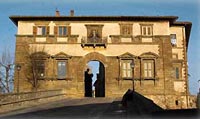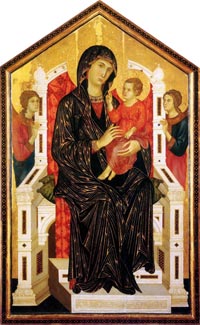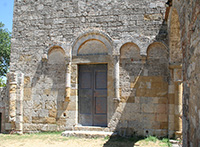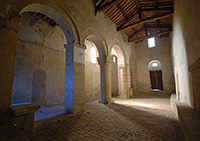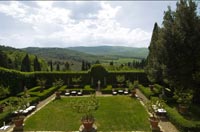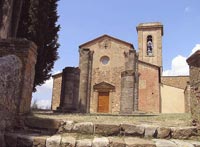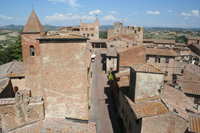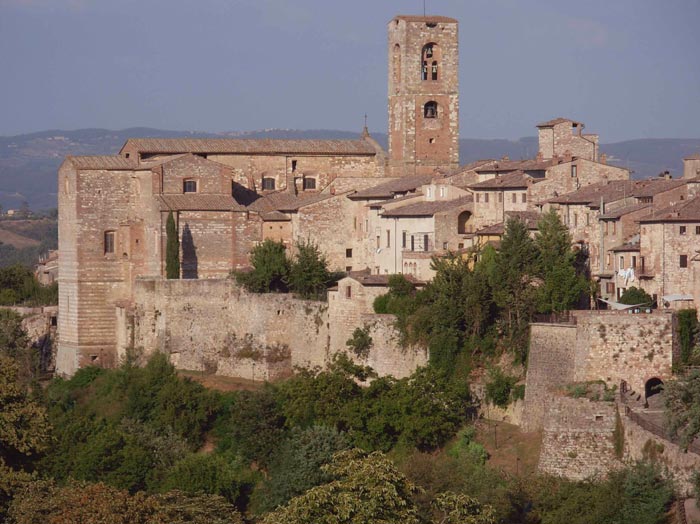 |
|
Colle Val d'Elsa
|
|
Colle di Val d'Elsa or Colle Val d'Elsa |
Locally referred to as Colle, Colle di Val d'Elsa is situated above the valley of the river Elsa, the Val d'Elsa which hosts towns like San Gimignano, Certaldo, Colle Val d'Elsa, Casole d'Elsa, Monteriggioni, Barberino Val d'Elsa and Poggibonsi. |
||||
 |
 |
 |
||
Colle di Val d'Elsa, panorama del centro storico |
Colle di Val d'Elsa, Duomo | Chiesa di Santa Maria in Canonica
|
||
The area of Colle, which was subject to the authority of Volterra, was an important crossroads to and from central and northern Etruria, a fact attested to by some very important finds, especially in the vicinity of two large necropolises: the Le Ville necropolis and the Dometaia necropolis.
|
||||
Porta Volterrana (Porta Nova)
|
||||
|
||||
| The Porta Nuova or New Gate opens onto Via Gracco del Secco, the main road in the old borgo, which is bordered by large residential palazzi. Their yellow plaster facades are in the late 18 C style and were added by Pietro Leopoldo di Toscana. Opposite one another are the hospital of San Lorenzo and the San Pietro conservatoire, with its adjacent church. Both of these buildings were built by the powerful Usimbardi family, to which the first Bishop of Colle di Val d'Elsa belonged. In mediaeval times, to pilgrims travelling along the road from Volterra to Colle di Val d'Elsa, the sight of the majestic and impressive Porta Nuova, with its large, round bastions, must certainly have been striking in its monumentality, as an emblem of the town’s beauty and importance. The monument represented the central role played by Colle di Val d'Elsa in the war between Florence, with its dependent territories, and the city of Sienna. The gate on the Volterra road was built on the site of the outdated Porta Selva, which was destroyed by troops allied to the Sienese during the siege of 1479. At the time, the bastions and the battlements were already present, while the gateway as it appears today, giving access to the Borgo di Santa Caterina, was built together with the new outer walls by the Florentine architects Cecca, Francione and Giuliano da San Gallo. Passing through the gateway, one finds oneself in Via Gracco del Secco, the main road in the old borgo, which is bordered by large residential palazzi and local eateries. Beneath their facades of yellow plaster, in the late 18th century style, which were added by Pietro Leopoldo di Toscana, one finds, standing opposite each other, the former hospital of San Lorenzo and the former San Pietro conservatoire, with its adjacent church. Both these buildings were built by the powerful Usimbardi family, to which the first Bishop of Colle di Val d'Elsa belonged. The hospital of San Lorenzo, built in 1635, bears clear signs of Leopoldo’s extension, and was carried out by Bernardino Fantastici, whereas the San Pietro conservatoire, which was completed in 1606 to plans by Giorgio Vasari the Younger, was originally home to lay sisters of the Augustinian order, and was later a home for young girls. It is now the Civic and Diocese Museum of Religious Art. One of the Museum’s masterpieces is the Maestà by the Badia a Isola Master, painted in the style of Duccio. The collection also boasts a rare eucharistic set dating to the 6 C and a wooden crucifix by Marco Romano, as well as a large group of works of art ranging from the mediaeval period to the 20 C.
|
||||
| The Borgo of Santa Caterina is the location of the former homes of numerous merchants dating back to the 13th century and 16 C, in which one can still detect the original shape of the towers, and from Piazza Baios one can admire the towered structures of the medieval buildings in Via dell'Amore and Via del Refe Nero. The only surviving part of the old Porta Vecchia (demolished in 1764) is the imposing Renaissance bastion which was used as a water cistern, and from which the network of the town’s water conduits used to lead, supplying fresh water to the Mercatalis Fountain, situated in Piazza Santa Caterina. Continuing down the road, one comes to the 15 C Church of Santa Caterina d'Alessandria, adjacent to which are the Oratorio dei Filippini and the Oratorio della Compagnia dalle Croce, where can still find the early 16 C terracotta group showing the Lament Over the Body of Christ, attributed to Zaccaria Zacchi.
|
||||
 |
 |
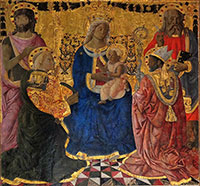
|
||
Museo San Pietro, sale del Museo Diocesano
|
Pier Francesco Fiorentino, Madonna col Bambino e Santi, 1470-90 ca., Museo civico e d'arte sacra (Museo San Pietro) (Colle di Val d'Elsa)
|
Pier Francesco Fiorentino, Madonna col Bambino e i santi Giovanni Battista, Lorenzo, Marco e Nicola, (XV secolo), Chiesa di Santa Maria in Canonica
|
||
The square opposite the house identified as that of the humanist and Lutheran theologian Aonio Paleario, who was burnt at the stake in 1570 in Rome, offers a welcome spot where one can relax in the shade of the trees and admire the attractive countryside of the Tuscan hills, and a fine view of the Church of San Francesco, one of the first sites of the Franciscan Order in Tuscany (1229).
|
||||
| Campana bridge |
||||
Alongside the Town Hall or Palazzo Comunale stands the Campana bridge, which joins the Borgo and the Castello districts, giving access to the town center. |
 |
|||
| Palazzo Campana |
View on Palazzo Campana, from under the Campana Bridge
|
|||
Colle Alta, has well preserved the typical medieval structure with narrow paved lanes, steeply sloping streets and flights of steps. An arch opening in the facade of the beautiful Palazzo Campana leads to the town. The 16th century palace, an example of Italian Mannerism, was built by Giuliano di Baccio d’Agnolo, and marks the entrance to the Castle, Il Castello di Piticciano, the oldest part of Colle. |
||||
 |
 |
 |
||
Colle di Val d'Elsa, Palazzo Pretorio
|
Colle di Val d'Elsa, Palazzo Campana | Palazzo Campana, l'Arco
|
||
| Colle di Val d'Elsa boasts three different museums, as well as an important library, that houses several important archives, as well as a large collection of antique and modern books. |
||||
R. Bianchi-Bandinelli Museum of Archaeology | Piazza del Duomo, Palazzo del Duomo |
||||
|
||||
| Le Ville necropolis and the Dometaia necropolis |
||||
|
||||
The Diocese Museum of Religious Art | Via del Castello, 31 |
||||
|
||||
| Museum of Lead-Crystal Glass | Via dei Fossi (ex area-Boschi) | www.cristallo.org |
||||
|
||||
| The gore, artificial water channels | ||||
| As its name shows this village is situated on the Elsa River which flows straight to the bigger Arno River. Along the Elsa banks there are many villages, as Poggibonsi and Certaldo, but Colle has a special relationship with this river. Even in the mediaeval period, the town covered a large area including Il Piano which extended along the route of the original gore. The gore are the artificial water channels supplied by water from the river Elsa. The town developed along the river from the 11th century onwards, building an artificial canal to power various industrial activities, such as wheat mills and paper factories. In this sense, the gore were a crucial factor in the town's economy, fostering the development of industrial enterprises. Il Sentierelsa is a beautiful walk along the Elsa river through the town of Colle di Val d'Elsa. The itinerary begins at Gracciano, you will find the stairs to this beautiful path and the waterfalls of Diborrato next to the Ponte di San Marziale. |
||||
|
|
|||
 |
 |
|||
L’Elsa, la steccaia e il Callone Reale al Ponte di San Marziale
|
Le gore di Colle di Val d'Elsa |
|
||
| Neighboring towns of Colle di Val d'Elsa are Casole d'Elsa, Monteriggioni, Poggibonsi, San Gimignano and Volterra. Surrounding smaller towns and hamlets: Borgatello, Bibbiano, Campiglia, Castel San Gimignano, Collalto, Coneo, Gracciano, Le Grazie, Mensanello and Quartaia. |
||||
Parish Church of Santi Ippolito e Cassiano in Coneo |
||||
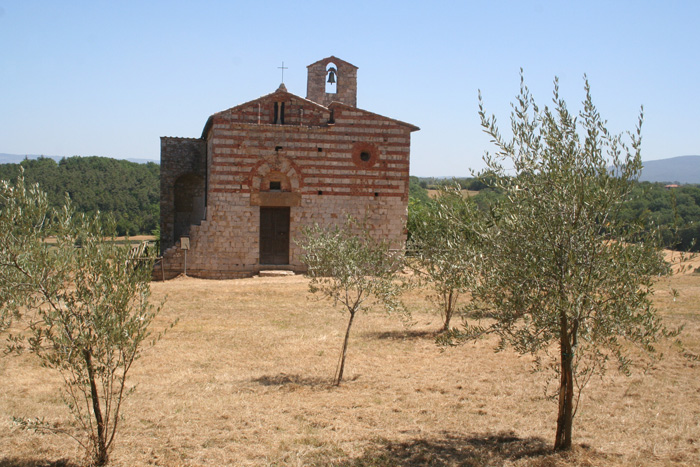 |
||||
Pieve of SS. Ippolito and Cassiano
|
||||
| The country church of Santi Ippolito e Cassinao existed as far back as the 10th century, and was later part of the bishopric of Volterra. Towards the end of the 12th century it came into the sphere of political influence of the municipality of Colle. From that time on, it did not flourish particularly, possibly due to a descrease in the local population. Whatever the explanation, as early as 1413 it was found to be largely in ruinsThe original layout had three naves and three apses. Today only the central and the left naves remain. The upper part of the faqade is covered by a lively red and white bi-colored faqade, typical of the Siena-Volterra area, with a type of masonry that alternates one stone rank with two brick ones, according to a type that is also found, in the Montesiepi Hermitage, not far from Coneo. The remains of a blind loggia with a double-lancet window are on the upper part of the faqade, anda circular opening corresponds to the bell tower. The completely bare interior has a variety of pillars and richly decorated capitals. The Parish Church of Santi Ippolito e Cassiano in Coneo is reached by a small road set beyond Campiglia dei Foci, on the road that goes from Colle Val d`Elsa towards Volterra. |
||||
Abbazia di Conèo
|
||||
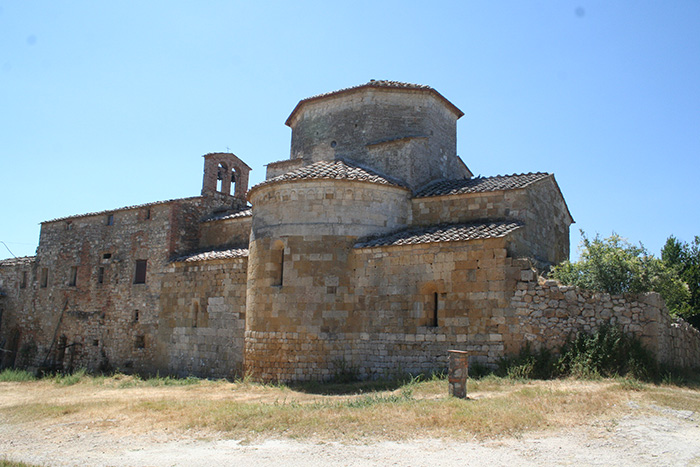 |
||||
The Abbey of Santa Maria Assunta in Conèo
|
||||
Abbazia di Conèo, Badia a Coneo near Campiglia, is a Romanesque structure that was founded by the Vallombrosan monks at the start of the 12 C and is one of the most interesting examples of religious architecture near Colle Val d'Elsa. Its plan is in the shape of the Latin cross, as is typical of Vallombrosan churches, and the intersection of the nave and the transept is surmounted by a sectioned dome, which is octagonal inside. The internal capitals and the cornice which runs round the outside of the building are decorated with starred flowers and other geometrical devices, of great artistic beauty. The building possesses a number of pre-Romanesque features, with numerous external brackets in the shape of imaginary animals. Pievi or small churches in Tuscany | The Abbey of Santa Maria Assunta in Conèo |
||||
| Casole d'Elsa |
||||
Casole is a little idyllic hilltop town with the most beautiful country side surrounding it. The area counts 3.000 inhabitants called Casolesi. Casole d'Elsa is an extensive Commune and is placed close to the source of the river Elsa. For this reason the area was highly populated back in Etruscan times, and several remnants can be found in the area. |
|
|||
| Archaeology and Collegiate Church Museum | PIAZZA DELLA LIBERTA', 1 | Opening time: 10-12 and 16-19 (spring and summer); Tues. to Sat. 15-18, Sun. 10-12 and 15-18 (fall and winter) • closed Mon. |
||||
| Villa La Suverana in Casole d'Elsa |
||||
| Villa La Suverana is situated in Maggiano, a frazione of Casole d'Elsa. The term suvera is a corruption of the French noun souveraine, or sovereign. The first records of the building date back to 1138, when it was the property of the powerful Longobard family, the Ardengheschi. In the mid-16th century, Pope Julius II (Giuliano della Rovere) received the villa as a gift from Pandolfo Petrucci, lord of the Republic of Siena. The pope ordered that what was then an austere fortress be transformed into a splendid Renaissance villa, surrounded by a large park, and the famous Sienese architectect Baldassarre Peruzzi was commissioned to carry out the plan. The present owners, the Ricci marquises, have now turned the villa into a five-star country hotel. The grounds have several interesting features: a large courtyard to the north, with a fine 18th-century ironwork aviary at its centre; an Italian-style garden adorned with potted lemon trees; and another garden to the south with a lily pool; a wood of holm-oaks crossed by winding paths is also part of the estate. [read more] |
||||
| Villa San Chimento |
||||
| Villa San Chimento, built in the late 16th century by the Accarigi family in località Scorgiano, is an imposing two-storey building with a fine portico at the centre of the main front, in front of which is a terrace which is reached by a broad polygonal flight of steps. Adjoining the building is an attractive Italian-style garden, set out with circular flower-beds edged with box hedges and crossed by a winding path. Inside the property is an ancient oil press that is still in use. | 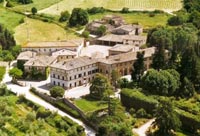 |
|||
| Parish Church of Santa Maria and Gervasio in Marmoraia |
||||
| The Parish Church of Santi Maria e Gervasio is found in Marmoraia, Casole d`Elsa. The small populated area of Marmoraia has only a few scattered houses and a Romanesque church, recorded for the first time in 1047. The building still maintains a part of its character as a medieval fortification, which hides the faqade. It is accessed through a door in the defensive wall. The building has three naves divided by arches that start with simple quadrangular pillars but that have been greatly altered in subsequent eras. It is still possible to see traces of its original form on the gabled fagade. Of the four elongated windows, only the center two are original. |
||||
| Barberino Val d'Elsa |
||||
| Barberino Val d'Elsa, situated high up above the valley from which it takes its name and halfway between Florence and Siena, on the north-western borders of the Chianti area. The town is still characterised by a historic medieval centre set out in an oblong or shaft-shaped form. Historically Barberino was tied to Florence for its important strategic location overlooking both directions of Florence and of Siena. For this reason the surrounding area is full of castles and fortified buildings. Barberino Val d'Elsa comune |
||||
| Pieve di Sant'Appiano |
||||
| Sant'Appiano is built on a pleasant hill, surrounded by cypresses, just a few kilometres from Barberino Val d’Elsa. The complex includes a Romanesque parish church, the ruins of an octagonal building, a cloister, a presbytert and a group of houses which constituted the village. The natural beauty of this area offers a suitable resting place for the relics of Saint Appiano. Etruscan tombs have been discovered near the parish church. The Parish church is documented as early as 990 CE and parts of the left nave, the apse and the crypt are pre-Romanesque. The parish church of Sant’ Appiano is the oldest medieval pre-Romanesque church in Tuscanys. It has retained its original apse and part of the north aisle, neither of which were damaged when the bell-tower collapsed in 1171. The remainder of the church was rebuilt soon after. Opening Hours: Summer: Saturdays and Sundays, 4pm-7:30pm Winter: Saturdays and Sundays, 3pm-6pm |
|
|||
| Antiquarium di Sant'Appiano |
||||
| Antiquarium di Sant’Appiano is a small archaeological museum located in rooms adjoining the Pieve di Sant’Appiano. It houses some of the considerable amount of material found on archaeological digs in the surrounding area. |
||||
| Certaldo |
||||
| Birth town of 14th century poet and writer Giovanni Boccaccio, Certaldo is a very evocative hilltop town of fairytale beauty. The old town on the hill is accessed by a funicular, but there is also a fairly large newer city which keeps quite busy thanks to the industries that have settled in the area. The town counts a good 16.000 inhabitants, a number that hasn't changed much over the past 20 yrs. The town has a fascinating past which goes back to pre-Etruscan times, and during the middle ages it took form thanks to its vicinity to the via Francigena (Roman road). It's medieval history is much entwined with that of Florence. |
||||
| Poggibonsi |
||||
| Poggibonsi is the largest town in the Val d'Elsa and at the same time it's the least touristy of all. Reason being that Poggibonsi was more or less leveled with the ground during the war and has been rebuilt almost completely from scratch. The central position has made the surroundings of Poggibonsi a perfect area for important industries to settle. |
||||
| Radicondoli |
||||
| Radicondoli confines to the South of the Elsa Valley and to the North of the Merse This hilltop town is tucked away between the mounts and offers incredible views. Among the several churches in Radicondoli, is the Collegiata dei Santi Simone e Giuda, with works by Pietro di Domenico and Alessandro Casolani.Other important monumentsare the Pieve di San Simone (Saint Simon Parish), the Convento di San Francesco (Saint Francis Convent) and the Castello di Elci (Elci's Castle). |
||||
| San Gimignano |
||||
| San Gimignano is a small walled medieval hill town and is mainly famous for its medieval architecture, especially its towers. While in other cities, such as Bologna or Florence, most or all of their towers have been brought down due to wars, catastrophes, or urban renewal, San Gimignano has managed to conserve fourteen towers of varying height which have become its international symbol. The heart of the town contains the four squares, Piazza della Cisterna, Piazza Duomo where the Collegiata church is located, Piazza Pecori, and Piazza delle Erbe. The main streets are Via San Matteo and Via San Giovanni, which cross the city from north to south. There are many churches in the town: the two main ones are the Collegiata, formerly a cathedral, and Sant'Agostino, housing a wide representation of artworks from some of the main Italian renaissance artists. The Communal Palace, once seat of the podestà, is currently home of the Town Gallery, with works by Pinturicchio, Benozzo Gozzoli, Filippino Lippi, Domenico di Michelino, Pier Francesco Fiorentino, and others. |
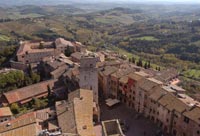 San Gimignano and the Val d'Elsa |
|||
| Pievescola | La Suvera |
||||
Relais La Suvera, a former medieval castle and Papal villa, stands high on a hill, overlooking rolling Tuscan countryside and Chianti vineyards. |
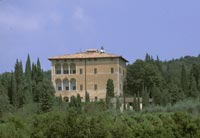 La Suvera |
|||
Comune Colle di Val d'Elsa |
||||
The Francigena in provincia di Siena Via Francigena | From San Gimignano to Monteriggioni |
||||
| Total length (km): 29.8 Travel time on foot (h: min): 7.30 Paved roads: 19% Dirt roads and driveways: 70% Mule tracks and trails: 12% Getting to the starting point: FS Empoli-Siena Railway Line, Poggibonsi station; bus line 133 for S. Gimignano This 29.8 km leg begins in San Gimignano and takes in about 7 hours to complete. It is one of the most beautiful legs of the Via Francigena, and after the frst section of the path, you begin to walk up and down in the valley of the Foci river, near Molino d'Aiano. A path leads upward to the Romanesque church of Santa Maria a Coneo. Then you cross the bridge on the hilltop to reach the Romanesque church of San Martino di Strove. Then you go to the Abbey of Island, before catching a sight of Monteriggioni, with its unmistakable ring of walls and towers that dominate the surrounding hills. |
 |
|||
| Via Francigena | From Gambassi Terme to San Gimignano Via Francigena | From Monteriggioni to Siena |
||||
Hidden secrets in Tuscany | Holiday home Podere Santa Pia
|
Organic winegrowing in Tuscany
|
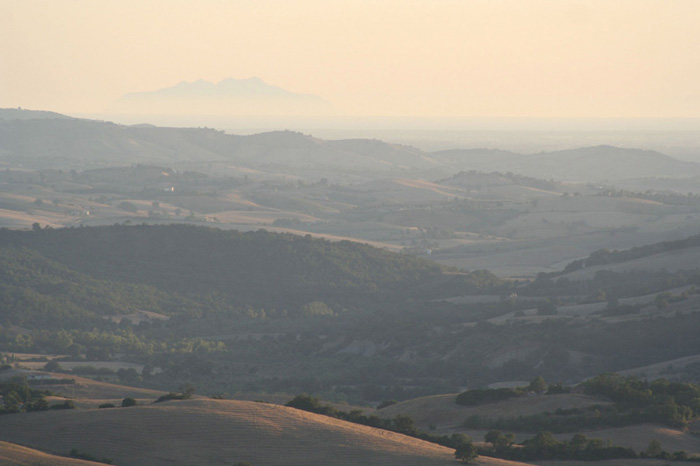 |
Podere Santa Pia is a peaceful retreat, perfect for relaxing with a magnificent panoramic view of the Mediterranean Sea and the island of Montecristo
|
Restaurants in Colle di Val d'Elsa Ristorante Arnolfo | Via XX Settembre, 50 | tel. 0577 920549 This exclusive restaurant is located in the historic centre of the town in the indoors of a 16th century Palazzo. Because they only offer arround 6 tables (for four persons) it is very familiar. It has a beautiful panoramic terrace and is considered as one of the best restaurants in Tuscany having received numerous awards over the years. The wine cellar offers an excellent variety.
|
[1] Photo by LigaDue - Own work, CC BY-SA 4.0, Link |


